The City of Santa Fe is committed to curating a street lighting design that’s best for everyone.
Operations and Maintenance
Dalkia is now performing services, meaning we are performing routine maintenance as well as approved repair work on city-owned street lights to keep the street lighting network functioning properly.
- To report an outage or malfunction, please utilize the map below to determine if the light is owned by the City of Santa Fe or Public Service Company of New Mexico (PNM).
- To report a city-owned light outage or malfunction, use the form below or call us at (505) 219-3780
- To report a PNM-owned light outage or malfunction, please visit PNM.com/streetlights.
FAQ
Isn’t the street light just the light itself?
It actually is not! Behind the luminaire, there is further infrastructure like wiring, fuses and overhead or underground power lines that all must be intact to keep the luminaire on during the night.
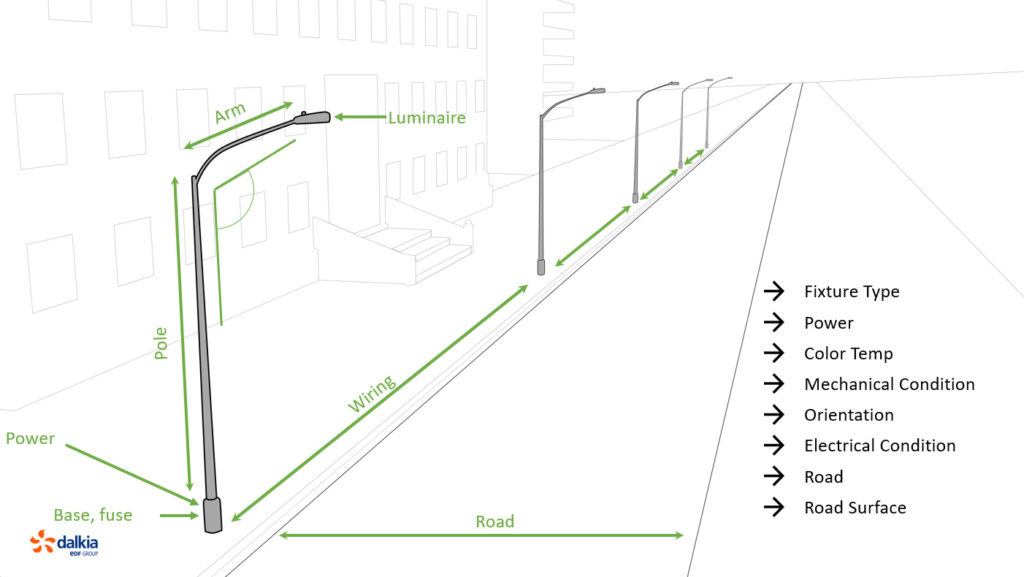
Sometimes, poles are knocked down by vehicles. Pole arms and luminaires can also be damaged by wind or other inclement weather.
What is the difference between maintenance and repairs?
Maintenance: scheduled and unscheduled work performed from the base of the pole to the luminaire to address normal wear and tear.
- Scheduled maintenance is designed to optimize the lighting performance and reduce the outage rate through proactive monitoring of the street lighting system. We perform work to prevent outages from occurring.
- Unscheduled maintenance addresses outages or malfunctions that have occurred due to normal wear and tear.
- Maintenance examples: replacing a failed luminaire, blown fuses or corroded wire in the pole.
Repairs: work necessary to address issues beyond normal wear and tear, caused by deterioration, damage or abnormal wear.
- Repair examples: vehicle knocked down a street light pole, underground wire theft, construction-related outage or outage due to a PNM power source issue.
Dalkia is performing all routine maintenance work on city-owned street lights based on safety and lighting level priorities. All of this work is covered by the annual maintenance payment. Repair work is not covered by the maintenance payment, and circumstances requiring repair work will be presented to the city along with a quote. The pricing on the quote provided to the city will be based on the “Unit Price List”, which is part of the contract. The city has discretion to approve or deny repair work and Dalkia will respond accordingly.
How fast will a light be fixed once an outage is detected or reported?
The Global Management Performance Contract between the City of Santa Fe and Dalkia outlines specific timeframes for Dalkia to respond to incidents in the city based on various priorities.
Dalkia is committed to maintaining an outage rate of less than 2% throughout the city. When a light is detected or reported out, it could be caused by numerous issues.
- If it is a single street light, Dalkia crews will visit the light within five (5) business days.
- If it is more than three street lights in series, Dalkia crews will visit the site within two (2) business days.
Upon arrival in any case, the crew will troubleshoot and perform routine maintenance activities immediately on site, if possible.
If troubleshooting leads to the discovery of work required beyond routine maintenance to make the light fully functional, meaning a repair is necessary, Dalkia crews will take notes and photos on site which will be utilized in a report and quote sent to the City of Santa Fe for approval prior to the work being performed. If it is approved, Dalkia will make necessary repairs within six (6) weeks (subject to material availability).
Are there other circumstances Dalkia will be responsible for, besides maintenance and repairs?
As part of the maintenance payment, Dalkia maintains emergency on-call field personnel who are operational 24 hours a day, 365 days a year. On-call technicians have the authority to take initiatives and make decisions in emergency situations.
Emergency response scenarios include:
- Those caused by outside influences, presenting an immediate danger to the public, such as a vehicle striking a pole or downed wires;
- Those caused by faulty system elements, such as a faulty cable or bad splice causing a mass outage; and
- Those that would not normally be deemed an emergency but for extenuating circumstances, such as a “light out” in an already under-lit area or a missing base door on a pole in close proximity to a school or day care center.
During an emergency scenario, Dalkia’s on-call personnel will be on site to secure the scene within three (3) hours.
Dalkia will also be assisting the City of Santa Fe with adding and removing street lights where appropriate to standardize and ensure the city’s roadways are appropriately illuminated.
What are the specifications of the new LED street lights?
The Community-Guided Smart Street Lighting Design specifications approved by the Governing Body on May 26, 2021 are summarized in the table below. All city-owned street lights will also feature a smart node.
| Roadway Type | Correlated Color Temperature (Kelvin) | Input Wattage Range (W) | Nominal Lumen Output Range (lumen) | Minimum Color Rendering Index | IES Distribution | Visual Comfort Refractor | IES TM-15 Backlight, Uplight, and Glare Rating |
Part Number |
||
| B | U | G | ||||||||
| Residential | 2700K | 28-45 | 4,000-5,000 | 70 | Type 2 | Required | 1 | 0 | 1 | ATBS P10 MVOLT R2 27K MP VR P7 |
| Local/Collector | 3000K | 90-100 | 8,900-12,000 | 70 | Type 2 or Type 3 | Required | 2 | 0 | 2 | ATBS P60 MVOLT R2 3K MP VR P7* |
| Major | 3000K | 190-200 | 20,000-24,000 | 70 | Type 2 or Type 3 | Not required | 3 | 0 | 3 | ATBM P70 MVOLT R2 3K MP P7 |
There are a few square fixtures on Governor Miles Road which will require a different fixture type due to the mounting needs. Those fixtures will receive: ATB0 P203 MVOLT R2 3K BZ MP P7
Street lights on NMDOT-owned roads will not be converted until NMDOT guidelines are updated to allow 3000K color temperature luminaires.
Implementation
The work of converting the city-owned street lights to the LED luminaires selected through Community-Guided Design phase was completed at the end of February!
If you’re interested in seeing the detailed progress reports delivered to the Public Works and Utilities Commission throughout the conversion, please see the files linked below.
Updates: 03-02-22 | 02-16-22 | 02-02-22 | 01-19-22 | 01-05-22 | 12-8-21 | 11-17-21 | 11-03-21 | 10-20-21
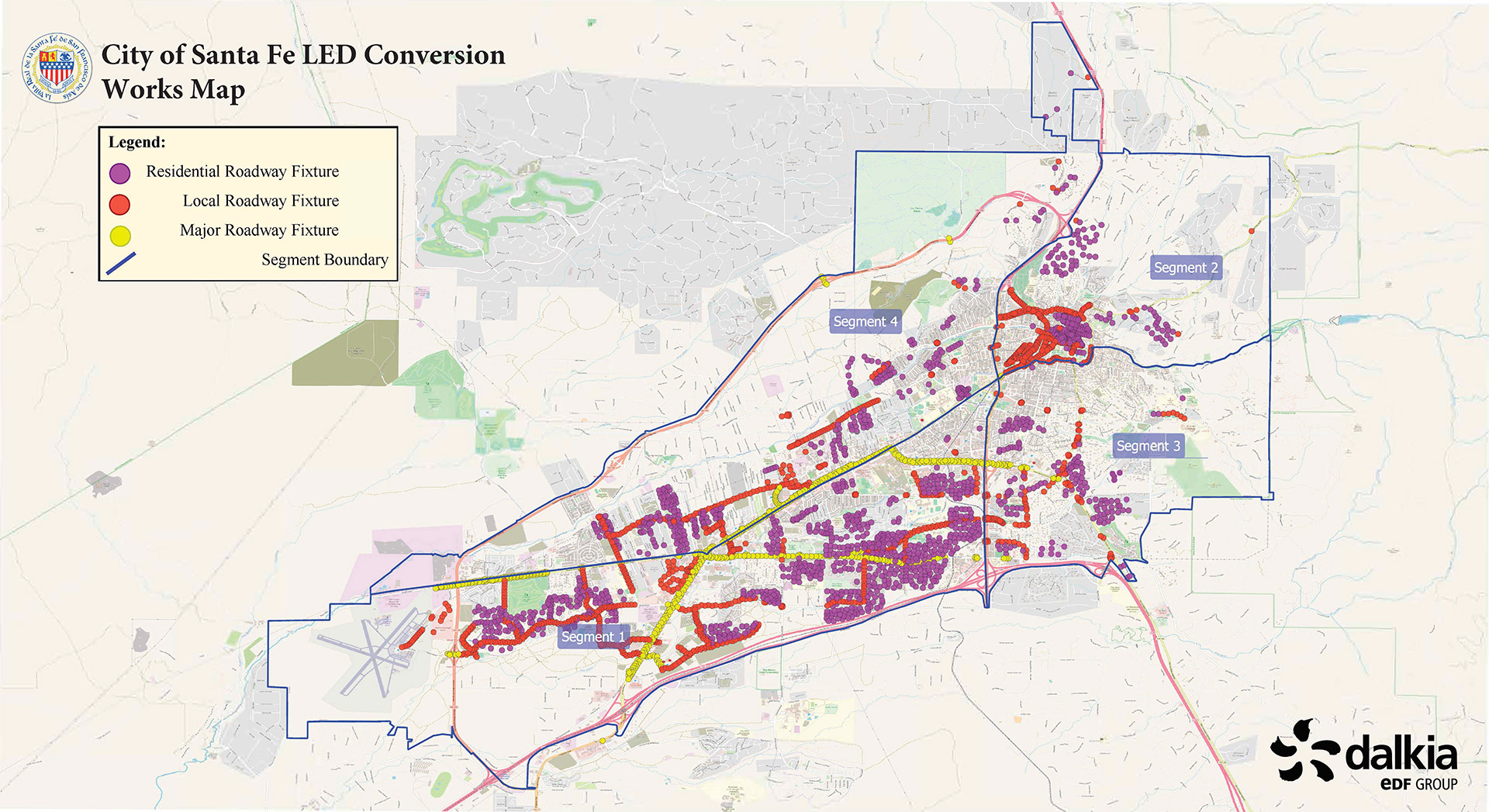
Design Validation
Dalkia captured drone footage of select areas across Santa Fe for before and after comparison. Each video captioned “Before” shows the lighting conditions with the old HPS or old LED lights. Each video captioned “After” shows the lighting conditions now that the street lights have been converted to LED following the Community-Guided Smart Street Lighting Design Plan.
In Segment 1, Governor Miles represents a Residential roadway, Camino Carlos Rey represents a Local roadway, and St. Michael’s represents a Major roadway.
In Segment 2, all streets shown represent Residential roadways except Paseo de Peralta, which represents a Local roadway. There were no Major roadways in Segment 2.
In Segment 3, Neighborhood at Old Pecos Trail and West Zia Road represents Residential roadways, Botulph Road represents a Local roadway, and St. Michael’s Drive represents a Major roadway.
In Segment 4, Las Acequias Neighborhood represents a Residential roadway, Rufina Street represents a Local roadway, and Cerrillos Road represents a Major roadway. Please note the street lights on the North side of Cerrillos Road are owned by PNM and have not yet been converted to LED.
Project Benefits
The City of Santa Fe is proud to partner with Dalkia Energy Solutions, EDF Group and the Public Service Company of New Mexico (PNM) to upgrade the city’s infrastructure through a more energy-efficient and cost-effective LED street lighting system.
The city is taking steps to convert all fixtures, including both city-owned and utility-owned street lights.
Santa Fe’s dedication to a street lighting system that serves all communities is codified by our Outdoor Lighting Ordinance:
“Reduce light pollution, reduce or prevent glare, reduce or prevent light trespass, conserve energy, promote a sense of safety and security, and ensure aesthetically appropriate outdoor lighting in keeping with the character of Santa Fe” (Ord. No. 2011-37 § 10)
Dalkia is proud to partner with the City of Santa Fe to exceed the expectations set forth by the ordinance.
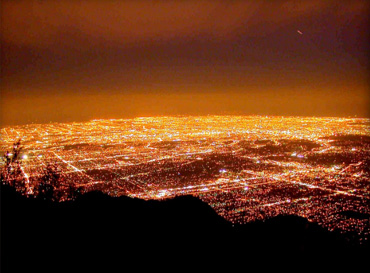
View from Mt. Wilson before LED Retrofit Project
(Los Angeles Basin, 2008)
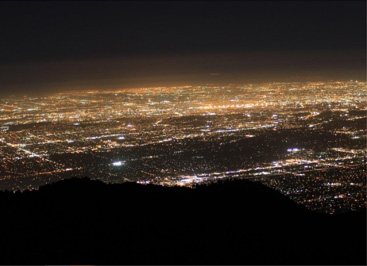
View from Mt. Wilson after LED Retrofit Project
(Los Angeles Basin, 2012)
The current high-pressure sodium street lights are riddled with problems, including:
- High failure rate
- Consumes an enormous 5.4 million kWh annually
- Little or no shielding, allowing light to spill upward into the night sky and into homes
- Long delays and unreliable repairs
- Failure to meet dark sky lighting regulations and safety-security expectation
The new LED street lighting system will provide many benefits, including:
- Extremely low failure rate, 4x longer life span
- Saves 2 million kWh annually
- Strong, reliable maintenance—maximum 5 days for repair
- Smart technology allows for automatic outage reporting
- Full cutoff fixtures guarantee zero uplight, with additional shielding options available
- Safety improvements with more consistent, higher-quality lighting
- Light shining only on streets and sidewalks, reducing sky glow
Community-Guided Design
Ensured the citizens of Santa Fe understood the technical aspects of street lighting, important terminology is defined below:
Input Power (Watts)
The electric power consumption of light fixtures. Watts are comparable to fuel consumption, while lumens can be compared to miles traveled.
Lumen Output (lm)
The total visible light in all directions. The sum of candela measurements.
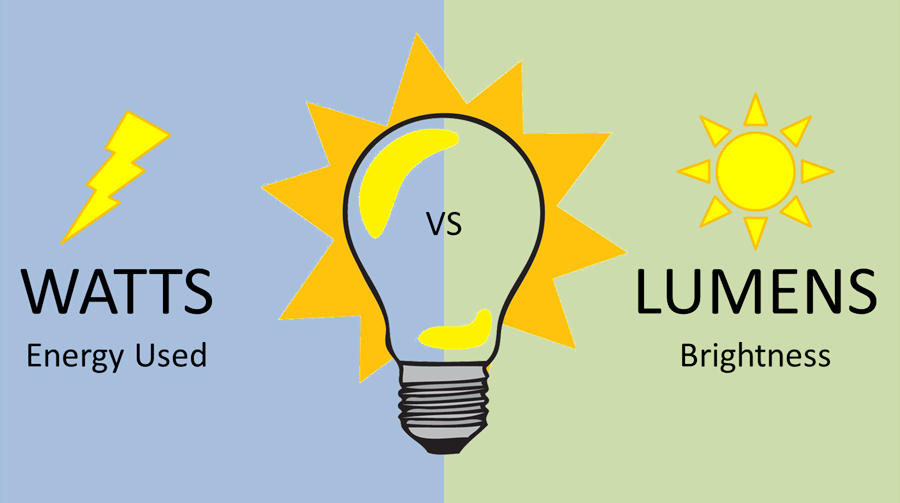 Image Source: https://www.sepco-solarlighting.com/blog/solar-lighting-design-guide-determine-wattage-/-lumen-requirements
Image Source: https://www.sepco-solarlighting.com/blog/solar-lighting-design-guide-determine-wattage-/-lumen-requirements
Correlated Color Temperature (CCT)
The temperature of the lamp measured in Kelvin (K). Lights which have lower color temperature appear more orange, while lights with a higher color temperature appear bluer. Important Note! Brightness is the measurement of lumen output, not color temperature.

Light Distribution
The throw of the light pattern surrounding each luminaire. Light distribution patterns can be further shaped by additional shielding.

Image Source: https://www.dominionenergy.com/north-carolina-electric/products-and-services/lighting-fixtures
Cut off
The amount of light allowed to spill above the horizontal plane of the fixture. All new LED fixtures will be “full cutoff,” meaning they provide 0% uplight. They also restrict backlight to the sidewalk, providing optimal application coverage without scattering light where it’s unwanted, like on private property or in house windows.
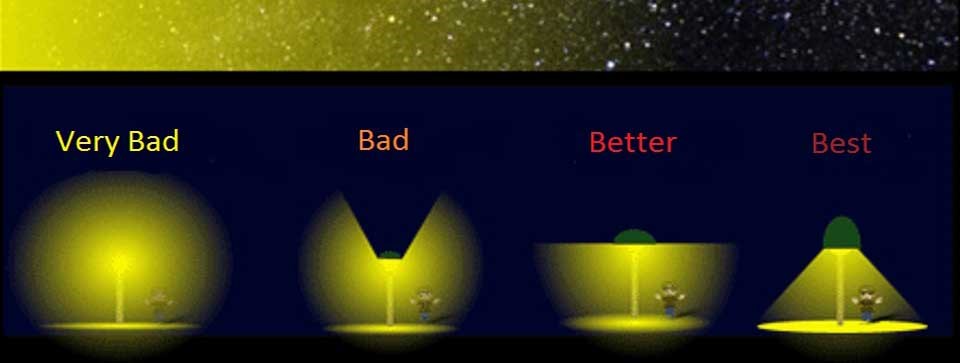
Image Source: https://www.nps.gov/grca/learn/nature/night-skies.htm
Dimming
The ability of the lumen output of the fixture to be reduced as needed. All city-owned fixtures will be dimmable and the dimming capability is extremely beneficial for night-sky and reducing artificial light impact on wildlife.
Light Shield
An easy and excellent way to prevent light trespass—shields direct light away from unwanted areas and back toward the road.
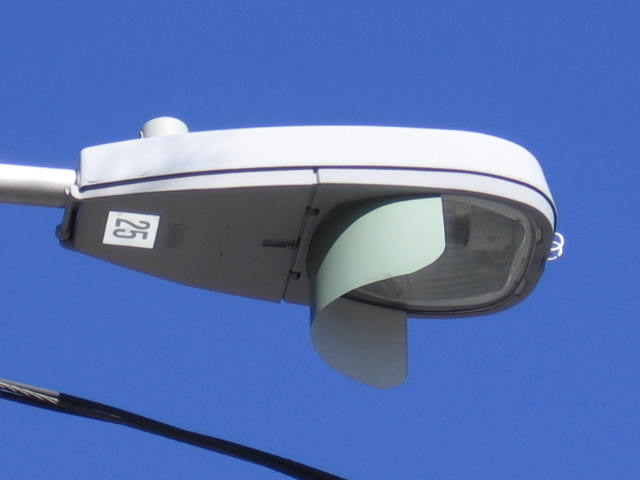
Image Source: https://chpn.net/2016/05/27/your-feedback-wanted-on-improving-the-streetlights/
We Want to Hear From You!
If you would prefer to provide feedback over the phone, call us at (505) 219-3780.


